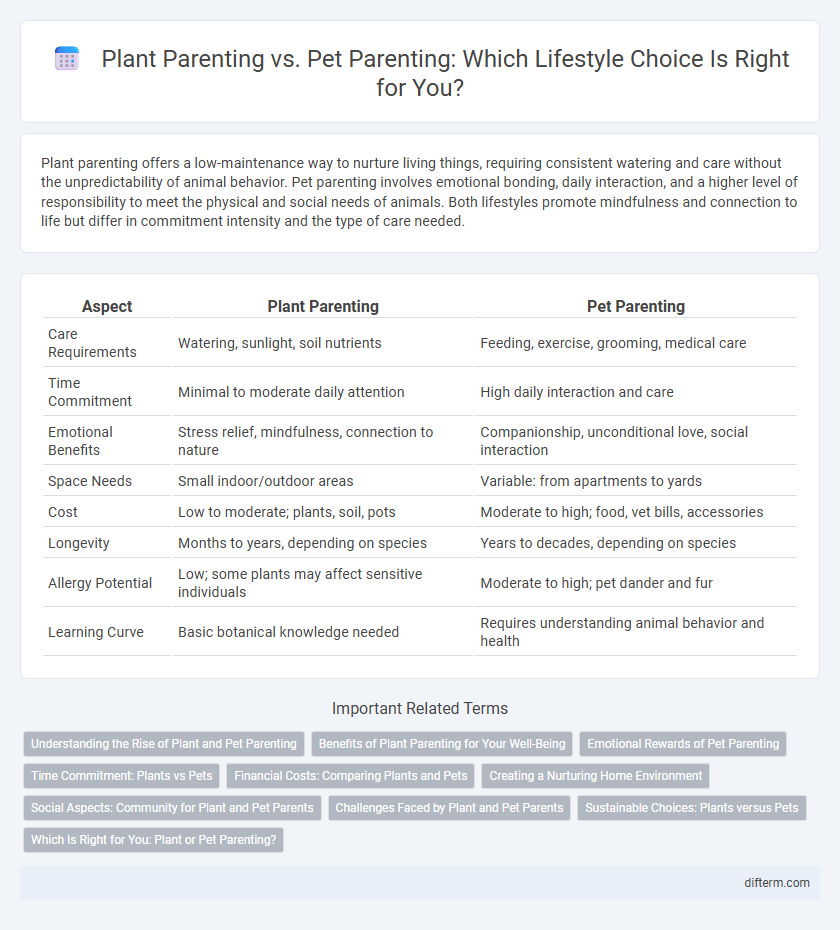Plant parenting offers a low-maintenance way to nurture living things, requiring consistent watering and care without the unpredictability of animal behavior. Pet parenting involves emotional bonding, daily interaction, and a higher level of responsibility to meet the physical and social needs of animals. Both lifestyles promote mindfulness and connection to life but differ in commitment intensity and the type of care needed.
Table of Comparison
| Aspect | Plant Parenting | Pet Parenting |
|---|---|---|
| Care Requirements | Watering, sunlight, soil nutrients | Feeding, exercise, grooming, medical care |
| Time Commitment | Minimal to moderate daily attention | High daily interaction and care |
| Emotional Benefits | Stress relief, mindfulness, connection to nature | Companionship, unconditional love, social interaction |
| Space Needs | Small indoor/outdoor areas | Variable: from apartments to yards |
| Cost | Low to moderate; plants, soil, pots | Moderate to high; food, vet bills, accessories |
| Longevity | Months to years, depending on species | Years to decades, depending on species |
| Allergy Potential | Low; some plants may affect sensitive individuals | Moderate to high; pet dander and fur |
| Learning Curve | Basic botanical knowledge needed | Requires understanding animal behavior and health |
Understanding the Rise of Plant and Pet Parenting
The rise of plant parenting and pet parenting reflects a growing desire for emotional connection and stress relief in modern lifestyles, with over 70% of millennials engaging in caring for houseplants or pets. Plant parenting offers benefits such as improved air quality and mental well-being, while pet parenting provides companionship and physical activity, both contributing to enhanced overall health. Market data shows a surge in sales of indoor plants and pet care products, highlighting the expanding cultural trend toward nurturing living beings for psychological and environmental benefits.
Benefits of Plant Parenting for Your Well-Being
Nurturing plants enhances mental well-being by reducing stress levels and promoting mindfulness through daily care routines. Unlike pet parenting, caring for plants requires less time and financial investment while improving indoor air quality and fostering a calm, nature-connected environment. The act of plant parenting encourages responsibility and creativity, contributing to overall emotional balance and personal growth.
Emotional Rewards of Pet Parenting
Pet parenting offers profound emotional rewards, including unconditional love, companionship, and stress relief that profoundly enhance well-being. Engaging with pets like dogs and cats boosts oxytocin levels, reducing feelings of loneliness and increasing overall happiness. Unlike plant parenting, the interactive nature of pet care fosters deeper emotional bonds and immediate responses, strengthening mental health through social connection.
Time Commitment: Plants vs Pets
Plant parenting demands consistent, often daily care such as watering, pruning, and monitoring light exposure, but generally requires less active engagement compared to pet parenting. Pets need substantial time for feeding, exercise, training, and social interaction, often involving multiple hours per day to maintain their physical and emotional well-being. The time commitment for pet parenting typically surpasses that of plant care, making it a more intensive lifestyle choice.
Financial Costs: Comparing Plants and Pets
Plant parenting typically requires lower financial investment, with initial costs including pots, soil, and seeds or starter plants, while ongoing expenses revolve around fertilizers and watering needs. Pet parenting incurs higher and more variable costs such as veterinary bills, pet food, grooming, and emergency care, which can significantly exceed plant maintenance expenses. Budget considerations often influence lifestyle choices, with plants offering an economical option and pets demanding substantial financial commitment over time.
Creating a Nurturing Home Environment
Creating a nurturing home environment requires understanding the unique needs of plant parenting versus pet parenting. Plants thrive with consistent light, water, and humidity, enhancing air quality and providing a calming atmosphere, while pets demand emotional engagement, regular exercise, and social interaction to foster a sense of security and belonging. Balancing these elements promotes a harmonious space that supports well-being and nurtures life in diverse forms.
Social Aspects: Community for Plant and Pet Parents
Plant parenting fosters a growing online community where enthusiasts exchange care tips, showcase rare species, and participate in plant swaps, creating a supportive network centered around growth and greenery. Pet parenting builds vibrant social circles through local meetups, pet-friendly events, and advocacy groups, strengthening bonds among owners through shared care experiences and pet wellness activities. Both lifestyles promote belonging and emotional connection, leveraging social media platforms and community forums to enhance interaction and support among members.
Challenges Faced by Plant and Pet Parents
Plant parents often struggle with maintaining optimal watering schedules and managing pests without harming their greenery, while ensuring adequate light and humidity levels proves challenging. Pet parents face difficulties such as behavioral training, managing dietary needs, and coping with health issues that demand time and emotional resilience. Both lifestyles require consistent attention and adaptability to nurture living beings effectively.
Sustainable Choices: Plants versus Pets
Choosing plant parenting over pet parenting often results in a lower environmental footprint due to reduced resource consumption such as water, food, and waste management. Indoor plants enhance air quality through natural filtration, contributing to healthier living spaces while requiring minimal energy compared to pets. Sustainable lifestyle choices favor plants for their ability to promote biodiversity and ecological balance without the intensive demands associated with animal care.
Which Is Right for You: Plant or Pet Parenting?
Choosing between plant parenting and pet parenting depends on your lifestyle, time commitment, and emotional needs; plants require minimal daily care and improve air quality, while pets demand consistent attention and offer companionship. Consider your living space, schedule flexibility, and desire for interaction--plants thrive in low-maintenance environments, whereas pets need active engagement and social bonding. Assess factors like allergies, budget, and responsibility to determine whether nurturing foliage or caring for animals aligns best with your wellness and routine.
Plant Parenting vs Pet Parenting Infographic

 difterm.com
difterm.com